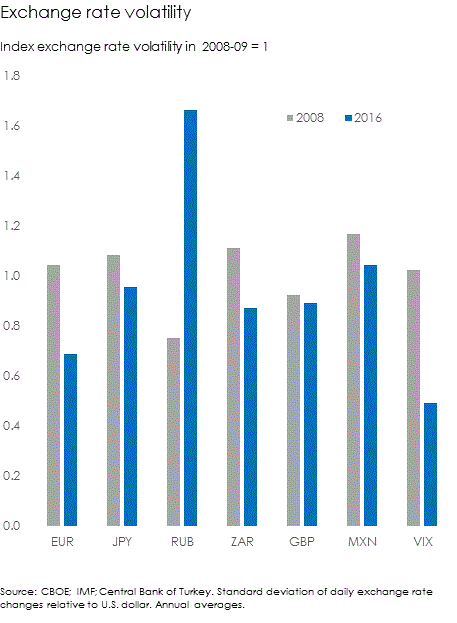Fear gauge
12 January 2017
Forget the VIX. The often quoted indicator for capital market sentiment has been only a timid reflection of market turbulence in 2016. In the eventful 2016, the VIX was half down from its 2008-09 highs. In contrast, exchange rate volatility had the highest reading since 2008-09 representing more than three quarters of the 2008-09 levels. Exchange rate volatility seems by far the better fear gauge.
Several important exchange rates saw their highest volatility against the U.S. dollar in 2016 since the 2008-09 events that triggered the global financial and economic crisis. The British pound was battered following the Brexit vote. The Japanese yen showed significant gyrations amid uncertainty about the direction of economic policies in Japan. The Mexican peso fell sharply when Donald Trump won the U.S. presidential elections.
Because, foreign exchange markets are the largest, deepest and almost always open, it is a good place to express one’s view about events in one country relative to events in another. The appreciation of a currency relative to another, then means that investors believe there is more relative value in the assets denominated in the appreciating currency.
Exchange rates ought to reflect simply the level of prices in one country relative to another. They rarely do at least not in the short term. Exchange rates also ought to reflect interest differentials between two countries. Again, they often do not. Instead, they pick-up rather well and instantaneously anything that seem to revise the view about a country. This makes exchange rates formidable sentiment indicators.
Exchange rates do reflect perceived relative economic prospects. The fall of the pound offers an unambiguous indication that investors think a U.K. outside the E.U. is a poorer and less interesting place. The pound depreciated 11 percent from US$1.4900 ahead of the vote to USD1.3372 the day after. The Trump win now raises prospects of repealing the North American Free Trade Agreement (NAFTA), the main platform for Mexico’s international trade, making Mexico a lesser place to do business. The Mexican peso fell 11 percent from US$0.0545 the day before the U.S. election to US$0.0483 afterwards.
Exchange rates are not meant to be that volatile. The volatility highlights that the international economy lacks adequate balance of payments adjustment mechanisms. It also reflects a lack of monetary policy credibility. The convergence of inflation rates, given the fact that inflation targets of the main central banks, excluding the People’s Bank of China, have been set uniformly at 2 percent, has had little to no effect on the respective exchange rates.
Exchange rate volatility is also a sign of perceived economic or broader economic policy divergence. High volatility denotes that markets believe that countries are adopting policies that will push them apart. It is therefore also indicative of the lack of appetite for economic policy coordination, the erosion of the institutional framework for economic policy dialogue like the G20 and in particular the increasing ineffectiveness of the IMF to act as the principal forum for international monetary cooperation.
The U.S. could itself become an important source of exchange rate volatility. The dollar remains the principal reference currency in foreign exchange. As such, it serves as an international unit of account and principal medium of exchange. It is also the main transmission channel of shocks emanating from the U.S. A less outward looking U.S. administration under President Trump may make the U.S. economy decouple more from the rest of the world. A highly expansionary economic policy may increase the risk of sudden reversals and built-up of large external imbalances.
Exchange rates often represent the single most important source of international investment returns. According to the IMF, cross-border portfolio investment stocks saw a dramatic drop from US$7.2 trillion in 2007 to US$4.3 trillion in 2008 but increased since to US$9.5 trillion in 2015 or 13 percent of world GDP. This raises the potential for high exchange rate volatility.
Looking forward, 2017 will host a large number of specific events with a high disruption threat, such as the tone of Trump’s inauguration in January, some though likely elusive progress on Brexit at end-March, national elections in France and Germany in May and October, respectively. 2017 will therefore likely be another highly volatile year for exchange rates. International investors better be prepared.
